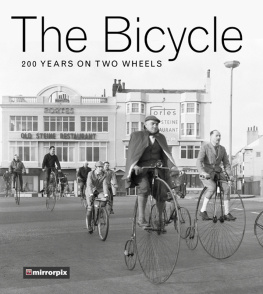
 All images are available to purchase from www.vintagephotosonline.co.uk First published 2017 The History Press The Mill, Brimscombe Port Stroud, Gloucestershire, GL5 2QG www.thehistorypress.co.uk This ebook edition first published in 2017 Mirrorpix, 2017 The right of Mirrorpix to be identified as the Author of this work has been asserted in accordance with the Copyright, Designs and Patents Act 1988. This ebook is copyright material and must not be copied, reproduced, transferred, distributed, leased, licensed or publicly performed or used in any way except as specifically permitted in writing by the publishers, as allowed under the terms and conditions under which it was purchased or as strictly permitted by applicable copyright law. Any unauthorised distribution or use of this text may be a direct infringement of the authors and publishers rights, and those responsible may be liable in law accordingly. EPUB 978 0 7509 8336 5 MOBI 978 0 7509 8337 2 Typesetting and origination by The History Press eBook converted by Geethik Technologies
All images are available to purchase from www.vintagephotosonline.co.uk First published 2017 The History Press The Mill, Brimscombe Port Stroud, Gloucestershire, GL5 2QG www.thehistorypress.co.uk This ebook edition first published in 2017 Mirrorpix, 2017 The right of Mirrorpix to be identified as the Author of this work has been asserted in accordance with the Copyright, Designs and Patents Act 1988. This ebook is copyright material and must not be copied, reproduced, transferred, distributed, leased, licensed or publicly performed or used in any way except as specifically permitted in writing by the publishers, as allowed under the terms and conditions under which it was purchased or as strictly permitted by applicable copyright law. Any unauthorised distribution or use of this text may be a direct infringement of the authors and publishers rights, and those responsible may be liable in law accordingly. EPUB 978 0 7509 8336 5 MOBI 978 0 7509 8337 2 Typesetting and origination by The History Press eBook converted by Geethik Technologies 
Foreword
In 1817, in the southwestern city of Mannheim, Germany, an inventor named Karl Drais created the first machine to employ the principles of propulsion we recognise in a modern bicycle, first riding this exciting new machine on 12 June of that year. His inelegantly named Laufmaschine, or the hobby horse or dandy horse as it was called in England, literally means running machine and requires the rider to perch on the two-wheeled contraption and use his feet to push along the ground, all the while steering by means of the front wheel and handlebar arrangement. Later on the French, very sensibly, added cranks and pedals to the mix and what became commonly known as the velocipede was born.
Michaux and Company began mass producing this revolutionary new vehicle in the 1860s and it was a great success, though not without its problems. The main issue was the shockingly uncomfortable nature of the ride, which led to it being given the disparaging moniker, Boneshaker. The penny-farthings large front wheel was an attempted response to this, but soon alternative safety bicycles were developed, enabling the riders feet to be near the ground, and keeping their feet away from the front wheel. The advent of the bicycle opened up a whole new world for both men and women. The thrill of personal transportation fuelled the bike boom of the 1890s and once an appetite for cycling had been firmly established, there was no turning back. Indeed, the humble bicycle played no small part in sustaining societies through world wars, peacetime strikes, demonstrations, womens suffrage all manner of historical events were aided by the ability to jump on a bicycle and pedal off independently and under ones own steam.
Today the bicycle enjoys a privileged position as one of the most globally successful means of personal transport, as well as a beacon of sportsmanship. Cycling sporting heroes have become icons, whether Olympians or Paralympians, or stars of Tours and road-races. The impressive Mirrorpix photographic archive, home to one of the worlds largest photographic libraries, with over 100 million images and more than a century of news coverage, is the perfect medium to present the changing fashions of the bicycle as it reaches its 200th anniversary. From dustmen to postmen, from children to soldiers, from amateur Polo clubs to Paralympians, these beautiful and evocative images reveal the power and impact of the bicycle upon society across the changing years. Put your feet up and enjoy the ride!  A rare picture of the pioneer members of the Novocastrian Cycling Club in 1891.
A rare picture of the pioneer members of the Novocastrian Cycling Club in 1891.  Tyneside cyclists take a breather after a day out in Northumberland in 1892.
Tyneside cyclists take a breather after a day out in Northumberland in 1892.  Family picnic in Birmingham c. 1900 featuring a Herald Motor Company (HMC) cycle.
Family picnic in Birmingham c. 1900 featuring a Herald Motor Company (HMC) cycle.  A gentleman on his bike in the early part of the twentieth century.
A gentleman on his bike in the early part of the twentieth century.  Jesmond Dene Cycle Club in 1912.
Jesmond Dene Cycle Club in 1912.  Although wounded this Belgian soldier could bicycle with a little assistance from his comrades, following the Battle of Auderghem, 26 September 1914.
Although wounded this Belgian soldier could bicycle with a little assistance from his comrades, following the Battle of Auderghem, 26 September 1914.  Soldiers seen here checking papers.
Soldiers seen here checking papers.  Soldiers seen here checking papers.
Soldiers seen here checking papers.
No one was allowed to proceed in Belgium without a passport and documents on which is the holders portrait. As can be seen in the picture the Belgian authorities have obliterated all the names on signposts in an effort to slow and confuse the German advance. (Daily Mirror, p. 4, 19 August 1914)  Belgian Boy Scouts carried messages deemed too private to trust to telegrams or ordinary messengers during the early stages of the First World War. Some were sent to France to gather the harvest whilst the men went off to the war. Belgian Boy Scouts were issued with pistols, as their work brought them close to the Front Line.
Belgian Boy Scouts carried messages deemed too private to trust to telegrams or ordinary messengers during the early stages of the First World War. Some were sent to France to gather the harvest whilst the men went off to the war. Belgian Boy Scouts were issued with pistols, as their work brought them close to the Front Line.
One Boy Scout became famous at the beginning of the war following the capture of two German spies dressed as priests near Liege. After this the boy, Joseph Louis Leyssen, seen in the photograph, was allowed to help on the Front Line, and more than once rode with important messages right through the German lines. He is seen here after being decorated following his fifth engagement with the enemy, in September 1914.  This is the new British Army Scout, in June 1915, known as the Divisional Cycle Corps, equipped with folding machines so that they could make a pursuit over any obstruction that may bar their way. It was considered one of the most useful units of the army.
This is the new British Army Scout, in June 1915, known as the Divisional Cycle Corps, equipped with folding machines so that they could make a pursuit over any obstruction that may bar their way. It was considered one of the most useful units of the army.  Doncaster Infirmary Appeal, October 1925.
Doncaster Infirmary Appeal, October 1925.
A student on a tall unicycle attempts to clear the course for the start of the races. 
Next page












 All images are available to purchase from www.vintagephotosonline.co.uk First published 2017 The History Press The Mill, Brimscombe Port Stroud, Gloucestershire, GL5 2QG www.thehistorypress.co.uk This ebook edition first published in 2017 Mirrorpix, 2017 The right of Mirrorpix to be identified as the Author of this work has been asserted in accordance with the Copyright, Designs and Patents Act 1988. This ebook is copyright material and must not be copied, reproduced, transferred, distributed, leased, licensed or publicly performed or used in any way except as specifically permitted in writing by the publishers, as allowed under the terms and conditions under which it was purchased or as strictly permitted by applicable copyright law. Any unauthorised distribution or use of this text may be a direct infringement of the authors and publishers rights, and those responsible may be liable in law accordingly. EPUB 978 0 7509 8336 5 MOBI 978 0 7509 8337 2 Typesetting and origination by The History Press eBook converted by Geethik Technologies
All images are available to purchase from www.vintagephotosonline.co.uk First published 2017 The History Press The Mill, Brimscombe Port Stroud, Gloucestershire, GL5 2QG www.thehistorypress.co.uk This ebook edition first published in 2017 Mirrorpix, 2017 The right of Mirrorpix to be identified as the Author of this work has been asserted in accordance with the Copyright, Designs and Patents Act 1988. This ebook is copyright material and must not be copied, reproduced, transferred, distributed, leased, licensed or publicly performed or used in any way except as specifically permitted in writing by the publishers, as allowed under the terms and conditions under which it was purchased or as strictly permitted by applicable copyright law. Any unauthorised distribution or use of this text may be a direct infringement of the authors and publishers rights, and those responsible may be liable in law accordingly. EPUB 978 0 7509 8336 5 MOBI 978 0 7509 8337 2 Typesetting and origination by The History Press eBook converted by Geethik Technologies 
 A rare picture of the pioneer members of the Novocastrian Cycling Club in 1891.
A rare picture of the pioneer members of the Novocastrian Cycling Club in 1891.  Tyneside cyclists take a breather after a day out in Northumberland in 1892.
Tyneside cyclists take a breather after a day out in Northumberland in 1892.  Family picnic in Birmingham c. 1900 featuring a Herald Motor Company (HMC) cycle.
Family picnic in Birmingham c. 1900 featuring a Herald Motor Company (HMC) cycle.  A gentleman on his bike in the early part of the twentieth century.
A gentleman on his bike in the early part of the twentieth century.  Jesmond Dene Cycle Club in 1912.
Jesmond Dene Cycle Club in 1912.  Although wounded this Belgian soldier could bicycle with a little assistance from his comrades, following the Battle of Auderghem, 26 September 1914.
Although wounded this Belgian soldier could bicycle with a little assistance from his comrades, following the Battle of Auderghem, 26 September 1914.  Soldiers seen here checking papers.
Soldiers seen here checking papers.  Belgian Boy Scouts carried messages deemed too private to trust to telegrams or ordinary messengers during the early stages of the First World War. Some were sent to France to gather the harvest whilst the men went off to the war. Belgian Boy Scouts were issued with pistols, as their work brought them close to the Front Line.
Belgian Boy Scouts carried messages deemed too private to trust to telegrams or ordinary messengers during the early stages of the First World War. Some were sent to France to gather the harvest whilst the men went off to the war. Belgian Boy Scouts were issued with pistols, as their work brought them close to the Front Line. This is the new British Army Scout, in June 1915, known as the Divisional Cycle Corps, equipped with folding machines so that they could make a pursuit over any obstruction that may bar their way. It was considered one of the most useful units of the army.
This is the new British Army Scout, in June 1915, known as the Divisional Cycle Corps, equipped with folding machines so that they could make a pursuit over any obstruction that may bar their way. It was considered one of the most useful units of the army.  Doncaster Infirmary Appeal, October 1925.
Doncaster Infirmary Appeal, October 1925.